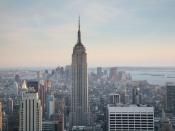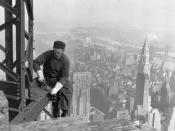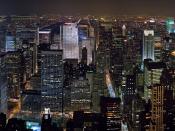During the year 1945, many Americans were celebrating the end of the European
war. A lieutenant colonel named William Smith, was one of the most remarkable people in the
1940s. He was a twenty-seven year old West Point graduate who was also a combat veteran.
Smith had flown for two years over European territories and was awarded the Distinguished
Flying Cross, the Air Medal, and the Croix de Guerre award for his wartime service in the
European war. Even though he was rewarded for what he had accomplished during the European
war, William Smith's life still ended tragically in an incident that has scarred the history of
America.
On Saturday, July 28, 1945, Lt. Col. William Smith was on his way to the Newark
Airport to pick up his commanding officer, while piloting a U.S. Army B-25 bomber through
New York City. When he decided to make a stop at the LaGuardia Airport to ask for the current
weather report, the LaGuardia tower commanded that he should land his plane because of the
heavy fog and the terrible weather conditions.
Smith decided to continue on his duty to pick
up his commanding officer, and even requested and received permission from the military to
continue flying to Newark. The last transmission from the LaGuardia tower to the plane was a
foreboding warning: "From where I'm sitting, I can't see the top of the Empire State Building."
Confronted with dense fog, Lt. Col. William Smith dropped the bomber lower than the
usual flying height to regain visibility, where he found himself in the middle of Manhattan,
surrounded by skyscrapers. At first, his plane was headed directly for the New York Central
Building; but at the last minute, Smith was able to aim the plane west and miss it. He managed
to miss several skyscrapers, until he was headed for the Empire State Building. When he finally
was able to see the building through the dense fog, Smith tried to get the bomber to fly upwards
and twist away, but it was too late.
At 9:49 a.m., the ten-ton, B-25 bomber smashed into the north side of the Empire State
Building. The plane crashed into the "Offices of the War Relief Services of the National
Catholic Welfare Conference." The majority of the plane flew into the seventy-ninth floor,
which created a hole in the building that was eighteen feet in width and twenty feet in length.
The plane's high-octane fuel exploded, which created hurtling flames down the side of the
building and inside, through the hallways and stairwells from the seventy-ninth floor, all the way
down to the seventy-fifth floor. According to Catherine O'Conner,
"The plane exploded within the building. There were five or six
seconds - I was tottering on my feet trying to keep my balance -
and three-quarters of the office was instantaneously consumed
in this sheet of flame. One man was standing inside the flame. I
could see him. It was a co-worker, Joe Fountain. His whole body
was on fire. I kept calling to him, "Come on, Joe; come on, Joe."
He walked out of it.
"Joe Fountain died several days later. Eleven of the office workers were burned to death,
some still sitting at their desks, others while trying to run from the flames." One of the engines
hurtled across the seventy-ninth floor, through wall partitions and two fire walls. The other
engine flew into an elevator shaft and landed onto an elevator car. The car began to plummet
while there were two women inside; but miraculously, the fire fighters had found and rescued
them just in time.
Overall, the plane crash killed fourteen people; eleven office workers and the three
crewmen that were boarded on the U.S. Army B-25 bomber. Luckily there were only twenty-six
injured. Though this accident can certainly be noted as a tragedy, some comfort can be found;
the loss of life was certainly not as great as it could have been. Had it occurred on a weekday,
the accident would have claimed many more casualties. If the plane had been a fully-armed B-25
bomber instead of a trainer, the destruction and devastation could have been catastrophic. The
lessons that can be learned by current or future air pilots or crew members from this tragic
incident, are: to always look for weather conditions before flying, to land the plane immediately
if conditions worsen, to never be stubborn, and to always listen to what the weather experts
suggest. Other individuals can also learn to always take precautions before doing anything.
Although this accident had devastated many individuals and had costed the lives of fourteen
victims, many individuals, from this tragic incident, can obtain many useful and positive rules
that they can live by.
Bibliography:
1. Goldman, Jonathan. "Book 66." An Article About The Plane Crash (1906). (1985).
2. Tauranac, John. "The Empire State Building."
An Article About The Making of a Landmark. (1995).
3. Goldman, Jonathan. The Empire State Building Book. New York: St. Martin's Press, 1980.
4. Tuning In Time. Ed. DJ Johnson. 2002. < http://www.cosmik.com/aa-april02/dj82.html >.
5. Empire State Building Sustained Crash. ABC News.
.
6. The Empire State Building Plane Crash. < http://www.evesmag.com/empirestatecrash.htm>.


